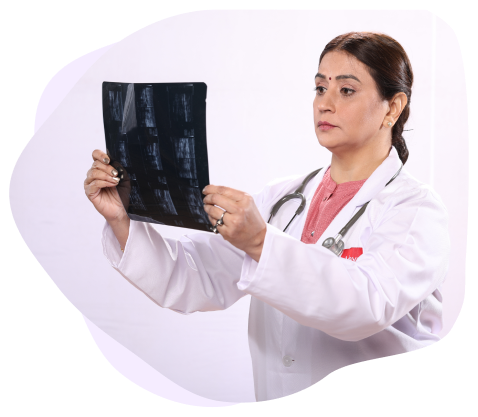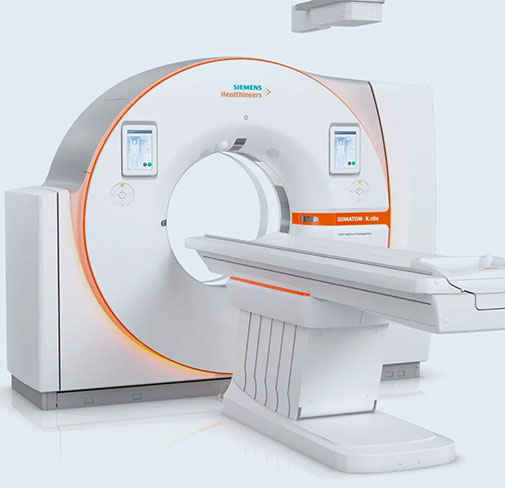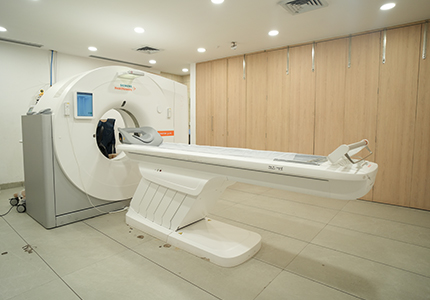
Radiology
Radiology, also known as diagnostic imaging, is a series of tests that take pictures of images of parts of the body. The field encompasses two areas - diagnostic radiology and interventional radiology.
A variety of imaging techniques such as Radiography, Ultrasonography, Computed Tomography (CT), Nuclear Medicine including Positron Emission Tomography (PET), Fluoroscopy, and Magnetic Resonance Imaging (MRI) are used to diagnose or treat diseases. Interventional radiology is the performance of usually minimally invasive medical procedures.
CT Scan
A CT scan is a medical imaging technique uses computers and rotating X-ray machines to create cross-sectional images of the body. These images provide more detailed information than typical X-ray images. They can show the soft tissues, blood vessels, and bones in various parts of the body
Computed tomography (CT) technology that uses 2 X- rays and 2 detectors at the same time, delivering high resolution images in half the time.
The imaging technique can help doctor:
- Diagnose infections, muscle disorders, and bone fractures
- Pinpoint the location of masses and tumors, including cancer
- Study the blood vessels and other internal structures
- Assess the extent of internal injuries and internal bleeding
- Guide procedures, such as surgeries and biopsies
- Monitor the effectiveness of treatments for certain medical conditions, including cancer and heart disease


CT scans don't require much preparation. If needed, you can do a CT scan with or without contrast very quickly. In fact, this happens in most cases where a CT scan is needed to diagnose traumatic injuries or a stroke.
If you're scheduled for a CT scan with contrast dye, it may help to refrain from eating solid foods for up to 4 hours before your test. This is especially true if your CT scan is being done to get images of your abdomen.
If your doctor is using oral contrast for your CT scan, you'll probably be given the contrast before the day of your scan and instructed on how to prepare and drink it. Generally, you will want to start drinking the solution within an hour or two of your scan, drinking a portion of the solution every 15 minutes.
Your doctor or radiologist will give you specific instructions. If you're having intravenous (IV) contrast, a catheter will be inserted into your vein when you arrive at the testing facility. Otherwise, the only preparations you need to take before a CT scan are to remove metallic objects and medication devices from your body. This includes jewelry & piercings, watches, glasses, hairpins, hearing aids, dentures, nicotine patches and other medication patches.
When it's time to begin the scan, you'll be positioned on a long narrow table, and you may be secured in place with velcro straps or other safety devices. The table will slide in and out of the circular scanner depending on which parts of your body need to be visualized.
The technician will leave the room before operating the scanner and may give you instructions over an intercom.
As the table moves in and out of the scanner, the machine will rotate around you making a loud noise. You may be asked to hold your breath or maintain certain positions. Otherwise, you should hold as still as possible to prevent the scanner from capturing blurry images.
Frequently Asked Questions
You might be nervous about the risks of imaging scans while pregnant, but the American College of Obstetricians and Gynecologists (ACOG) says the doses of radiation in a CT scan are far below what would cause harm to a developing foetus.
Ultrasounds and MRI scans are usually the first choices for pregnant people, but CT scans are safe and should not be avoided if medically necessary, according to ACOG.
A CT scan of the body can take 15 to 30 minutes, while a scan of the head alone can take about 5 minutes. In case of contrast is required, the procedure may take longer. However, you may need to allow extra time for each procedure in case there are delays or a need to repeat some scans. Your doctor or the office nurse will advise you how to plan your schedule for the day of the exam.
A CT scan is usually completely painless. The machine does not touch you and you do not feel the x-rays. Occasionally, some patients who are administered a contrast medium experience a side effect, usually involving only slight discomfort. This rarely occurs today because newer, safer products called nonionic contrast media have been developed, and they reduce most discomfort.
The table may move a short distance every few seconds to position you for each new scan, or the table may move continuously very slowly. You will hear clicking or buzzing sounds as the mechanism in the scanner moves around your body, making images from many different angles. It is important that you lie very still during the procedure so that the scanner can get the best possible pictures.
The entire procedure may take about an hour for a body scan and a half-hour for a head scan.
- After the exam is over, the radiologist will look at all the images to make sure they contain all the needed information. You will be asked to wait while this is done because sometimes it is necessary to do repeat scans or take additional scans.
- After the radiologist has a complete set of scans, you may change back into your clothes and go home. If you are a hospitalised patient, you may go back to your room.
- Unless you have other tests scheduled, you may eat normal meals after the exam and your doctor will suggest that you drink plenty of fluids. Fluids will help eliminate the contrast medium from your body.

